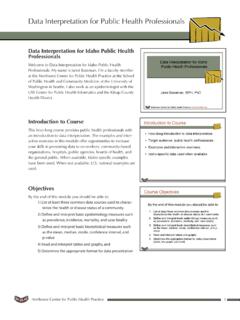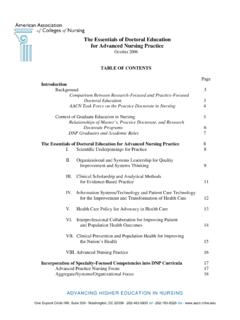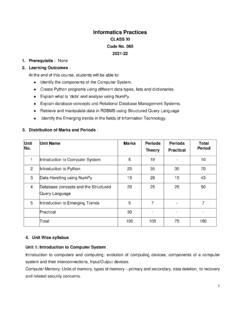Transcription of Global strategy on digital health 2020-2025
1 1 Global strategy on digital health2020-2025 Global strategy on digital health 2020-2025 ISBN 978-92-4-002092-4 (electronic version)ISBN 978-92-4-002093-1 (print version) World health Organization 2021 Some rights reserved. This work is available under the Creative Commons Attribution-NonCommercial-ShareAlike IGO licence (CC BY-NC-SA IGO; ). Under the terms of this licence, you may copy, redistribute and adapt the work for non-commercial purposes, provided the work is appropriately cited, as indicated below. In any use of this work, there should be no suggestion that WHO endorses any specific organization, products or services. The use of the WHO logo is not permitted. If you adapt the work, then you must license your work under the same or equivalent Creative Commons licence. If you create a translation of this work, you should add the following disclaimer along with the suggested citation: This translation was not created by the World health Organization (WHO).
2 WHO is not responsible for the content or accuracy of this translation. The original English edition shall be the binding and authentic edition .Any mediation relating to disputes arising under the licence shall be conducted in accordance with the mediation rules of the World Intellectual Property Organization ( ).Suggested citation. Global strategy on digital health 2020-2025 . Geneva: World health Organization; 2021. Licence: CC BY-NC-SA (CIP) data. CIP data are available at , rights and licensing. To purchase WHO publications, see To submit requests for commercial use and queries on rights and licensing, see materials. If you wish to reuse material from this work that is attributed to a third party, such as tables, figures or images, it is your responsibility to determine whether permission is needed for that reuse and to obtain permission from the copyright holder. The risk of claims resulting from infringement of any third-party-owned component in the work rests solely with the disclaimers.
3 The designations employed and the presentation of the material in this publication do not imply the expression of any opinion whatsoever on the part of WHO concerning the legal status of any country, territory, city or area or of its authorities, or concerning the delimitation of its frontiers or boundaries. Dotted and dashed lines on maps represent approximate border lines for which there may not yet be full agreement. The mention of specific companies or of certain manufacturers products does not imply that they are endorsed or recommended by WHO in preference to others of a similar nature that are not mentioned. Errors and omissions excepted, the names of proprietary products are distinguished by initial capital reasonable precautions have been taken by WHO to verify the information contained in this publication. However, the published material is being distributed without warranty of any kind, either expressed or implied. The responsibility for the interpretation and use of the material lies with the reader.
4 In no event shall WHO be liable for damages arising from its use. Graphic design: The New DivisionACKNOWLEDGEMENTS 2 INTRODUCTION 4 digital TECHNOLOGIES SHAPING THE FUTURE OF Global health 7 VISION 10 PURPOSE 11 GUIDING PRINCIPLES 15 1. Acknowledge that institutionalization of digital health in the national health system requires a decision and commitment by countries 15 2. Recognize that successful digital health initiatives require an integrated strategy 153. Promote the appropriate use of digital technologies for health 164. Recognize the urgent need to address the major impediments faced by least-developed countries implementing digital health technologies 17 STRATEGIC OBJECTIVES 191. Promote Global collaboration and advance the transfer of knowledge on digital health 192.
5 Advance the implementation of national digital health strategies 213. Strengthen governance for digital health at Global , regional and national levels 234. Advocate people-centred health systems that are enabled by digital health 26 FRAMEWORK FOR ACTION 301. Commit 302. Catalyse 303. Measure 314. Enhance and iterate 31 IMPLEMENTATION OF THE strategy AND ACTION PLAN 32 General implementation principles 32 Specific implementation principles 34 MONITORING AND EVALUATION 37 GLOSSARY 39 ANNEX PROPOSED ACTIONS FOR MEMBER STATES, THE SECRETARIAT AND PARTNERS FOR IMPLEMENTING THE Global strategy ON digital health 45 Contents2 The development of the Global strategy on digital health underwent a two-year co-creation journey before its adoption at the Seventy-third World health Assembly (WHA).
6 The initial draft of the strategy document was drafted and disseminated for comments through an internal consultation in early 2019. An outline of scheduled consultations was then communicated to Member States at an information session held in Geneva in March 2019, followed by a Global public consultation from March to May of the same year. Various consultations with Member States were held between June and October 2019, including a Global consultation convened in Geneva and a series of discussions during the regional committee meetings. The strategy was presented as part of the agenda item (EB146/26) in the Executive Board in February 2020. Having considered the report on the draft Global strategy on digital health , the board decided to recommend an adoption of the document to the Seventy-third WHA. In responding to the recommendation by the Executive Board, the secretariat conducted another two rounds of Member States consultation in February and July 2020 to further refine the language in the strategy document.
7 Under the leadership of Soumya Swaminathan, Chief Scientist, and Bernardo Mariano, Director of Department of digital health and Innovation, Sameer Pujari and Yu Zhao oversaw the development, coordination and consultation of the strategy document. The technical coordination was provided by (In Alphabetical order) Housseynou Ba, Patricia Codyre, Marcelo D Agostino, Jun Gao, Clayton Hamilton, Mark Landry, Ahmed Mandil, Mohamed Nour and Diana Zandi. Additional inputs were received from Flavio Aggio, Onyema Ajuebor, Virginia Arnold, Ayman Badr, Navneet Bahl, Maryam Bigdeli, Philippe Boucher, Marie-Charlotte Bouesseau, Craig Burgess, Kenneth Carswell, Giorgio Cometto, Valeria De Oliveira Cruz, Joan Dzenowagis, Gaya Gamhewage, Sebastian Garc a Sais , John Grove, Biswamber Gurubacharya, Celine Hazbun, Robert Jakob, Christopher Jones, Maki Kajiwara, Edward Kelley, Tarek Khorshed, Hans Kluge, Rameshe Krishnamurthy, Veerabhadra Kuchimanchi, ACKNOWLEDGEMENTSG lobal strategy on digital health 2020-2025 ACKNOWLEDGEMENTS3 Aleksandra Kuzmanovic, Ledia Lazeri, Tormod Lund, Myrna Marti, Clarisse Mason, Natela Menabde, Raman Minhas, Oliver Morgan, Lincoln Moura, Nhu Linh Nguyen, David Novillo Ortiz, Olushayo Olu, Ibrahim Ouakrim, Lorraine Pablo-Ugale, Andy Pattison, Liliana, Pievaroli, Bardan Rana, Marge Reinap, Andreas Reis, Elena Sartorius, Mubashar Sheikh, Norman Sinappen.
8 Peter Singer, Yves Souteyrand, Rutendo Urenje, Heini Utunen, Adriana Velazquez Berumen, Isabelle Wachsmuth, Tana Wuliji, Jean-Marie Yameogo. WHO collaborating centres, other UN agencies and entities, representatives from industry, civil society, academic and research institutes and many individuals also submitted inputs and suggestions during the public consultation department of digital health and Innovation would like to extend its gratitude to all Member States delegates who provided comments during the preparation of this document. The department would like to extend its appreciation to the digital health Technical Advisory Group (DHTAG) members. Additional contributions were also received from (In Alphabetical order) Louise Agersnap, Shada Alsalamah, Salim Azzabi Zouraq, Pascoal Bento, Billo Diallo, Javier Elkin, Noha Gamal El-Din, Isabel Hall, Melissa Harper Shehadeh, Garrett Mehl, Harry Meijer, Derrick Muneene, B reng re Nail, Patricia Ndumbi, Laxmi Panicker Graber, Violeta Perez Nueno, Tina D Purnat, Natschja Ratanaprayul, Mariam Shokralla, Mata Toure, Sudha Venkatram, Jane Wallace, Sheng strategy on digital health 2020-2025 ACKNOWLEDGEMENTS4 INTRODUCTIONIn 2005 the World health Assembly through its resolution on eHealth urged Member States to consider drawing up a long-term strategic plan for developing and implementing eHealth develop the infrastructure for information and communication technologies for promote equitable, affordable and universal access to their benefits.
9 Countries and stakeholders were urged to direct their efforts towards creating a consistent eHealth vision in line with a country s health priorities and resources, developing an action plan to deliver the proposed vision, and creating a framework for monitoring and evaluating eHealth implementation and progress. More than 120 Member States including low- and middle-income countries have developed such strategies and 2013, the health Assembly adopted resolution on eHealth standardization and interoperability, which urged Member States to consider developing .. policies and legislative mechanisms linked to an overall national eHealth strategy . Drawing on these resolutions and recognizing the need to strengthen digital health implementation, in May 2018 the health Assembly adopted resolution on digital health , in which it requested the Director-General to develop .. in close consultation with Member States and with inputs from relevant stakeholders.
10 A Global strategy on digital health , identifying priority areas including where WHO should focus its efforts . The strategy was developed through a consultative process launched in March 2019 that included discussions in online public forums, technical consultations, meetings of the WHO regional committees and the Executive Board at its 146th session1. The Global strategy on digital health 2020 2025 was endorsed by the Seventy-third World health Assembly in decision WHA73(28) (2020). The Global strategy on digital health builds on resolutions adopted by the United Nations General Assembly 2 and the World health Assembly,3 related WHO Global and regional Global strategy on digital health 2020-2025 INTRODUCTION1 See documents EB146/26 and EB146/REC/2, summary records of the thirteenth meeting, section Nations General Assembly resolutions 73/218 (2019) and 70/125 (2016).3 Resolutions (2005), (2013), (2016) and (2018); various resolutions of the regional committees include EM/RC53 (2006), AFR/RC56/R8 (2006), AFR/RC60/R3 (2010), (2011), AFR/RC63/R5 (2013) and WPR/RC69/8 (2018).















